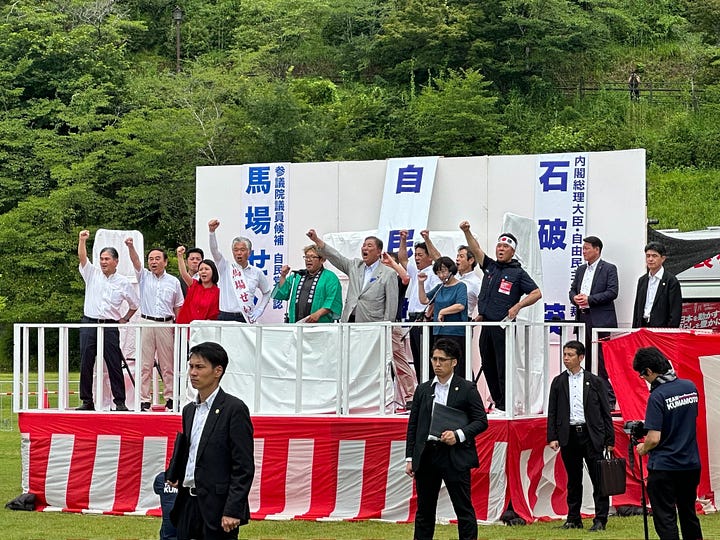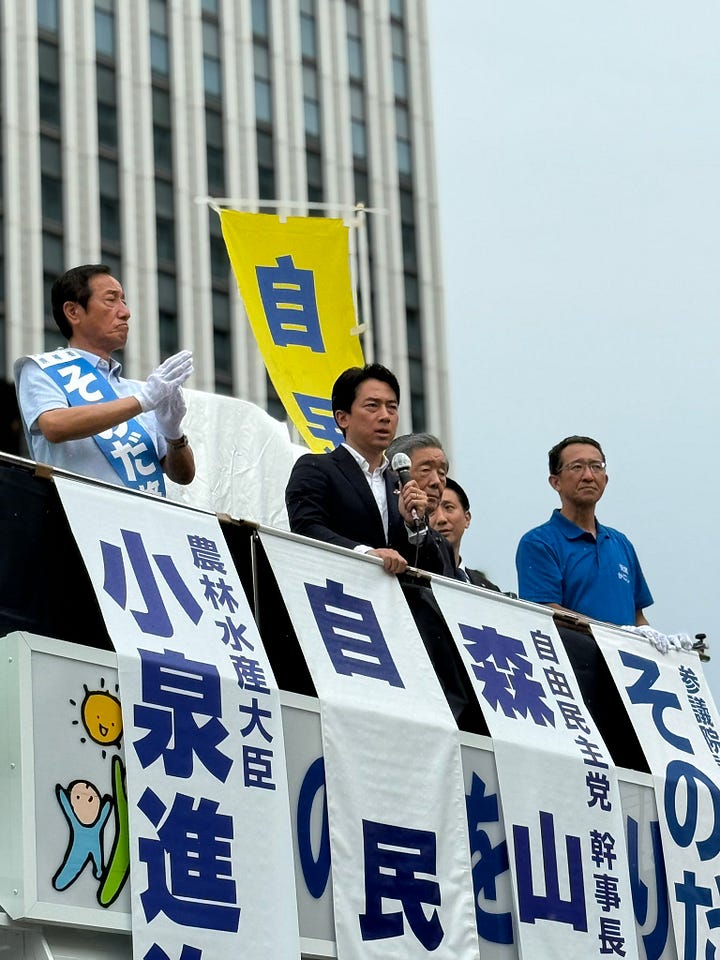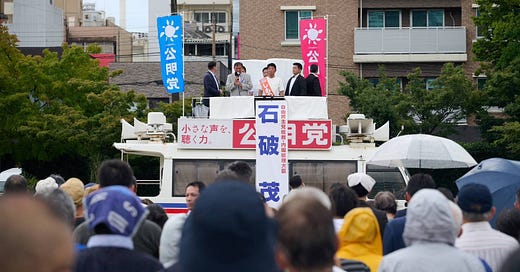One week to go | Today in the Upper House Campaign
With Sanseitō defying expectations, all parties are scrambling for position as they enter the final week of the campaign
This is the latest update for paid subscribers on the state of the upper house campaign, which will continue through the vote on 20 July.
Paid subscribers can access my forecast and viewer’s guide, including information on how to access a conference call on the elections for paid subscribers that will be held at 9am EDT on 14 July, at this link:
A pdf of the report can be purchased here.
If you are looking for timely, forward-looking analysis of the stories in Japans’s politics and policymaking that move markets, I have launched a new service through my business, Japan Foresight LLC. For more information about Japan Foresight’s services or for information on how to sign up for a trial or schedule a briefing, please visit our website or reach out to me.
I also have a new essay at Nikkei Asia discussing what is at stake for Japan in the upper house elections here.
The state of race
As the campaign enters its final week, both ruling and opposition party leaders are showing signs of anxiety about Sanseitō’s surging support. The party threatens to disrupt every party in different ways. For the LDP, the party could peel off right-wing LDP supporters, particularly in single-member constituencies; for Komeitō, Sanseitō is exploiting the party’s relative decline and could unseat incumbents in multiple constituencies; for the Democratic Party for the People (DPFP) and Ishin no Kai, the party is a contender for many of the same anti-establishment voters; and for the CDP and parties further to the left, the party’s rise is a source of deep anxiety about the direction of Japanese society and the rise of anti-foreigner sentiment.
A Mainichi Shimbun report on the race in Fukuoka and Kyushu more broadly shows these dynamics at work in a region that has been an LDP stronghold. Sanseitō could be threatening Komeitō’s hold on the third seat in Fukuoka prefecture, while blocking the DPFP from taking it. Meanwhile, the party’s strength in single-member prefectures in the region could be at the expense of LDP candidates, which could largely be to the benefit of the CDP and opposition-backed independents in the prefecture’s races. These dynamics can be found in prefecture after prefecture, across the country, with particularly desperate struggles for the marginal seats in the multi-member constituencies.


While Sanseitō’s rise may be the single most-discussed story of the campaign, the inexorable decline of Komeitō could be at least as important in its implications. The party’s national PR vote totals have been steadily falling, but it increasingly appears that this election could be the one in which the party’s sputtering electoral machine has real consequences for the ruling coalition. If the party does not have enough strength to hold the seats in multi-member districts that have been its “reserved seats” in election after election, it will likely be the difference between the ruling coalition’s maintaining or losing a majority in the upper house. What losing the majority due to Komeitō’s weakness would mean for its quarter-century-old coalition with the LDP remains to be seen but given that some in the LDP have been vocally opposed to the coalition, those voices could be more insistent, particularly if Prime Minister Ishiba Shigeru were replaced by a more conservative successor.
The campaign trail


For the Liberal Democratic Party (LDP) Prime Minister Ishiba Shigeru was in Aichi and Kochi prefectures on Saturday, 12 July and Kumamoto and Fukuoka prefectures on Sunday, 13 July. Koizumi Shinjirō spent the weekend in Kyushu, with stops in Oita, Fukuoka, and Saga on Saturday and Nagasaki and Kagoshima on Sunday. Kobayashi Takayuki was in central Japan, campaigning in four single-member constituencies, including Niigata and Okayama Saturday and Mie and Shiga on Sunday.1
Komeitō’s Saitō Tetsuo was in Nagano on 12 July and Ishikawa and Toyama on 13 July.
On Saturday, Constitutional Democratic Party (CDP) leader Noda Yoshihiko traveled to single-member constituencies in Tohoku that the party has a strong chance of winning, including Aomori, Miyagi, and Fukushima. He was Kyoto, Osaka, and Okayama on Sunday. CDP Secretary-General Ogawa Junya was in Tokyo on Sunday.
Democratic Party for the People (DPFP) leader Tamaki Yūichirō started in Miyagi and made his way southward on Saturday, stopping in multi-member districts in Ibaraki, Chiba, and Kanagawa. On Sunday, he started the day in Kanto with Saitama and Tokyo stops before heading to Fukuoka.
Ishin no Kai’s Maehara Seiji was in Shiga on Sunday again campaigned in his home prefecture of Kyoto on Sunday. Co-leader Yoshimura Hirofumi was in Tokyo, Saitama, and Ibaraki on Saturday and Hyogo and Kyoto on Sunday.
Sanseitō’s Kamiya Sōhei started the weekend in Kyushu, with stops in Kagoshima, Kumamoto, Saga and Fukuoka on Saturday and then traveled north on Sunday, campaigning in Miyagi, Ibaraki, and Chiba.
Japanese Communist Party (JCP) leader Tamura Tomoko was in Tohoku on Saturday, campaigning in Miyagi, Iwate, Aomori, and Fukushima. On Sunday she was in Kyoto and Shiga.
Keep reading with a 7-day free trial
Subscribe to Observing Japan to keep reading this post and get 7 days of free access to the full post archives.






